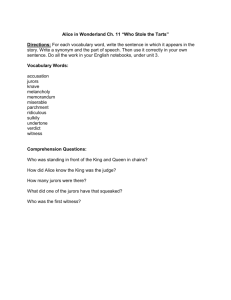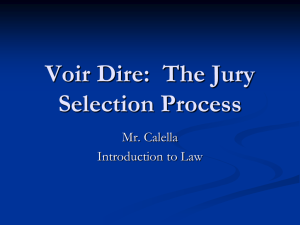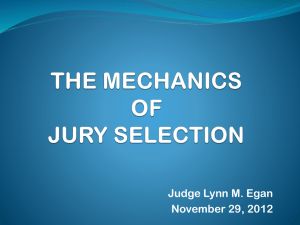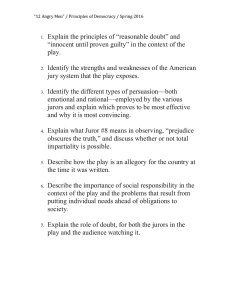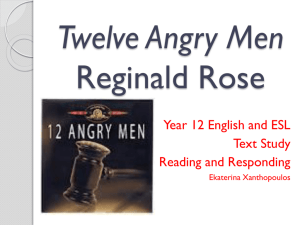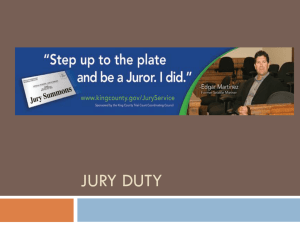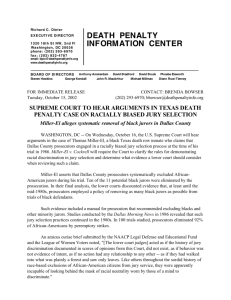Constructing Arguments: Logic & Critical Thinking
advertisement
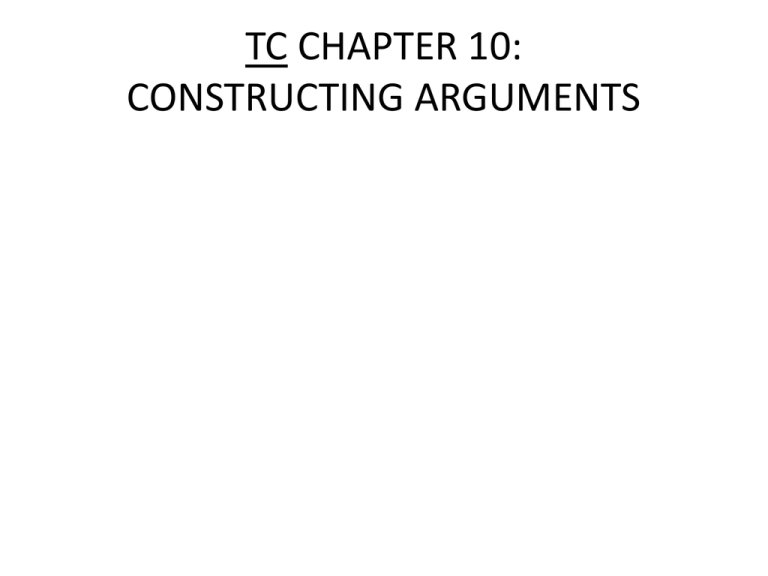
TC CHAPTER 10: CONSTRUCTING ARGUMENTS Cue words • Page 420 • Cue words signaling reasons • Cue words signaling conclusions • Define • Argument—a form of thinking in which reasons are used to form conclusions • Reasons--statements that support, justify, or increase the probability or likelihood of other statements • Conclusion—a statement that explains, asserts, or predicts on the basis of reasons Socratic syllogism: Application of a general rule • All a are b • X is an a. • Therefore, x is b. • You must be this tall to ride. • You are this tall < • You cannot ride. Modus ponens • Affirming the If the moon is right, I will antecedent; the way plan on planting that affirms by affirming tomorrow. The moon is right, • If a, then b. Therefore I will plan on planting tomorrow. • .a. . . . • . Therefore b! Modus tollens Denying the consequence; The way that denies by denying If a, then b. Not b! Therefore, not a! Ack! • If I am the hillside strangler, then I strangle people on the hillside. • I have no upper body strength and severe vertigo. • Therefore, I am not the hillside strangler. Modus tollendo ponens: the Disjunctive syllogism • A is either b or c • A is not c • Therefore a is b • A is b or c • c. • Therefore, not b. • I am either good or bad. • I am not always good, • Therefore I am bad. See pg 436 for examples from our journals. • Test next week; focus on Kant from Chapter 9 and evaluating arguments from chapter 10. • There will be one course-summative question. • You will need your book! 12 Angry Men • The movie was originally a play. In the play, twelve men, selected for a jury, are asked to judge the guilt or innocence of a young man accused of murdering his father. Throughout the course of the movie, the jurors discuss evidence and motive. You can see certain jurors begin to “think critically” as one member encourages them to think for themselves. • On the next page is a diagram of the jurors seated around the table in the jury room. The diagram may help orient you to the seating arrangement. None of the jurors are given names. Next week, turn in the answers to the questions that follow as ¼ of your exam grade. • SUPPORT ALL ANSWERS WITH EXAMPLES FROM THE FILM. • 1. Which character is the best critical thinker? 2. Which character is the worst critical thinker? Support your reasoning by referring to at least one specific example from the play. • 4. At what point do any TWO of the jurors become critical thinkers (Do not choose the juror you discussed in question #1.) Specifically, what happens to make each one think critically? 3. What perceptions or obstacles prevent any other TWO jurors from thinking critically (Do not choose the juror you discussed in question #2.) • 5. How does the film’s “look” change as the plot thickens, and how does this inform your reaction? • • Door JURY ROOM, 12 ANGRY MEN (by Reginald Rose) 1. Foreman, 35, small, petty Football Coach 12. Advertising man, 30 Doodler, snob _____________________ 2. Squeaky, 38, Bank Clerk, Meek __________________ T 11. immigrant, 48 3. Angry Man, 40, A Humble, suffered injustices Highly prejudiced (Lee J. Cobb) B 10. Bigot, 46 Comes to quick decisions (Ed Bagley) 4. Retired Man, 50 Stockbroker, rational (EC Marshall) L 9. Old Man, 70 Mild, gentle, has all his faculties 5. Mechanic, 25 Baltimore, grew up in slum (Jack Klugman) E 8. Our Hero, 42, Architect Mysterious, charismatic, dark & moody, used to power (Henry Fonda) 6. Everyman, 33, decent, housepainter not used to making decisions 7. Mr. Baseball, 42 loud, flashy, short tempered;

